Not all toilets are the same. While the basic function remains similar, there are some significant differences in flushing mechanisms—especially when it comes to push-button toilet flush systems. Among these, dual flush button toilets and pneumatic push-button flush systems have become particularly popular in modern homes.
Depending on the type of toilet, the design and function of the push-button flush system can vary. The most common types include single push-button and dual push-button toilets. However, other advanced types also exist, which we will explore in this article.
What Is a Push-Button Toilet Flush? (4 Types Explained)
A push-button toilet flush refers to a flushing mechanism where a button—usually located on the top of the toilet tank—is pressed to release water into the toilet bowl. With just a single press, the tank water is discharged, cleaning the bowl effectively.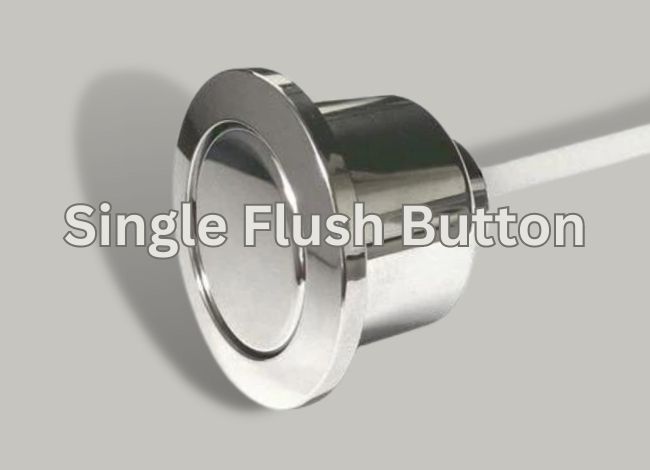
If the push button becomes faulty, the flushing system may not function properly, leading to hygiene issues or water waste.
There are four main types of push-button toilet flush systems:
- Single Flush Button
- Dual Flush Button
- Pneumatic Flush Button
- Electronic or Sensor-Based Push Button (additional category added for completeness)
Let’s break down the most common ones:
What is a single flush button? |
What is a dual flush button? |
| The single flush button system is based on older toilet technology. It uses a single, fixed volume of water—often up to 12 liters—for every flush, regardless of the waste type. This can lead to unnecessary water usage, making it less eco-friendly by today’s standards.
Although you may still find single flush systems in some homes or older buildings, they are not commonly used in modern toilets due to their inefficiency. |
A dual flush button toilet features two separate buttons—one for a half flush (typically around 3 to 4.5 liters) and one for a full flush (usually 6 to 9 liters). This design allows users to choose the appropriate water volume based on the waste type, offering significant water savings over time.
That’s why dual flush toilets are now widely adopted in modern bathrooms, as they are more environmentally friendly and cost-effective in the long run. |
Here’s an improved, grammatically correct, user-friendly, and keyword-optimized version of the first part of your article titled “What Type of Push-Button Toilet Flush Do I Need?”. I’ve also added missing or unclear information for better clarity and accuracy.
Cable-Operated Flush Button
A cable-operated flush button is one of the common types of toilet flushing mechanisms. It is usually located at the front, top, or side of the toilet cistern. What makes this type unique is that the flush button is connected to the flushing system through a flexible cable.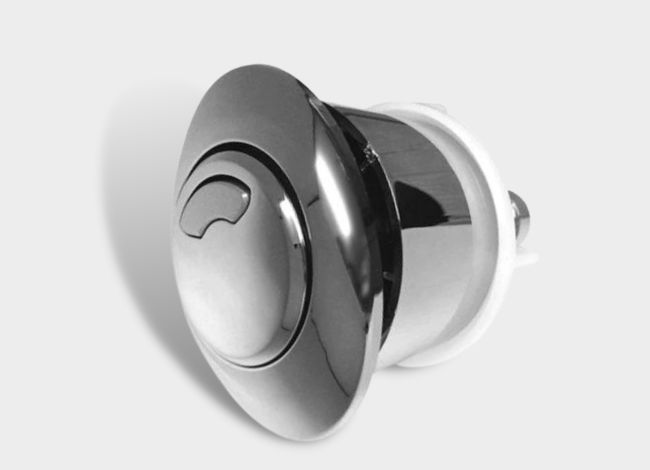
When you press the cable-operated button, it activates the flushing mechanism by pulling the flush valve via the cable. This opens the water flow and efficiently flushes the toilet. This type of flush system is ideal for modern bathroom designs, especially when the cistern is concealed or mounted in hard-to-reach places.
Key benefits:
- Easy to install in concealed or wall-hung toilet systems
- Flexible positioning of the button on the cistern
- Smooth operation
Pneumatic Toilet Flush Button
A pneumatic toilet flush button, also known as an air-operated flush, is a more advanced and efficient flushing method. It works by using air pressure to trigger the flush.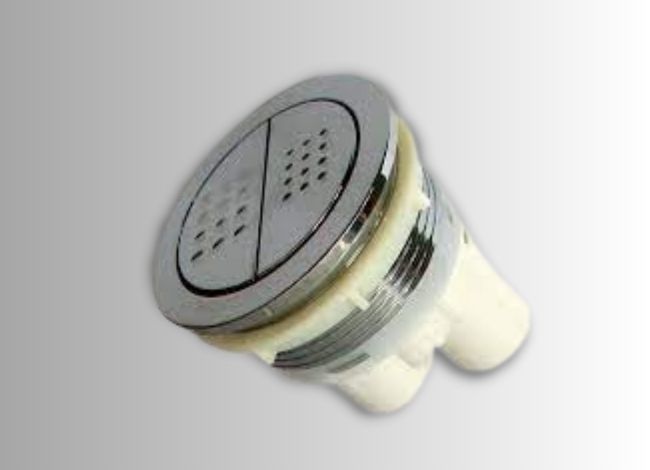
This system requires a pneumatic tube that connects the flush button to the outlet valve. When you press the button, air travels through the tube to operate the valve, releasing water to flush the toilet. If your toilet doesn’t have the appropriate setup (a pneumatic valve and tube), this type of button cannot be installed.
Ideal for:
- Wall-mounted or concealed toilets
- Homes prioritizing hygienic, soft-touch flush mechanisms
- Modern or luxury bathroom setups
How to Use a Dual Flush Button Toilet
A dual flush toilet features two buttons, typically one for a partial flush and the other for a full flush. This system is designed to save water by giving you flushing options based on the type of waste.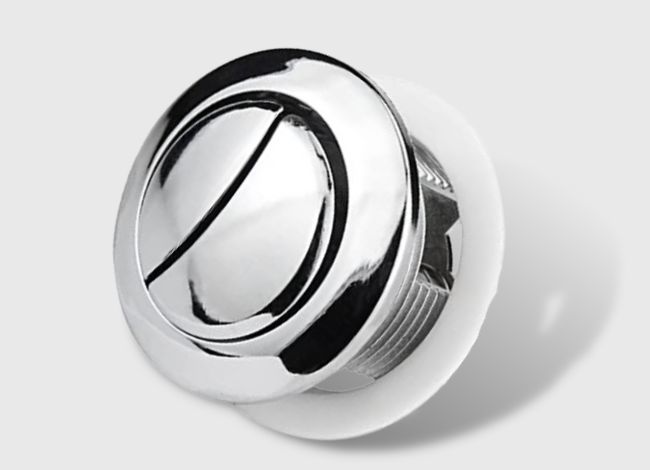
- Press the smaller button for a light flush (ideal for liquid waste like urine)
- Press the larger button or both buttons together for a full flush (for solid waste)
This eco-friendly design significantly reduces water usage compared to traditional flushing systems.
In simple terms:
- Use one button to flush pee
- Use both buttons for flushing poop
Can a Toilet Use Both Single and Dual Flush Buttons?
Most toilets are designed for either a single flush or dual flush system. However, some modern flush valves from brands like Fluidmaster, Siamp, and Dudley offer compatibility with both single and dual flush buttons. These valves give users the flexibility to switch between flushing options without changing the entire system.
What Are Toilet Flush Buttons Called?
While commonly known as toilet flush buttons, the internal mechanism they operate is called a toilet flapper or flapper valve. This component is essential for controlling the release of water from the tank into the bowl.
In modern push-button toilets, flappers may be replaced by flush valves or flush mechanisms, especially in dual flush systems. These terms are sometimes used interchangeably depending on the design.
Push-Button Flushing vs. Handle Flushing: Which Is Better?
Both push-button flushing and handle-operated flushing have their pros and cons, but push-button toilets are generally considered more efficient and modern.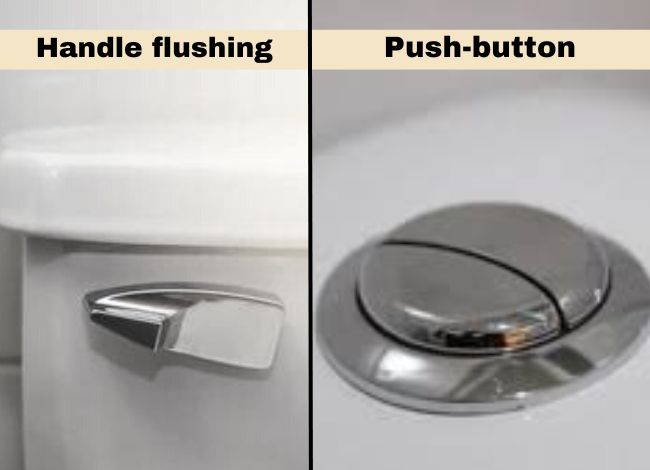
Advantages of Push-Button Toilets:
- Sleeker, space-saving design
- Faster and smoother flushing performance
- Water-saving options in dual flush models
- Easier to clean and maintain
Handle-operated systems are still used in older models and offer reliability but lack the modern efficiency and style of push-button mechanisms.
FAQs
1. How much water does a single-button or dual-button flushing system use?
Single-button flushing systems typically use around 1.6 gallons per flush (GPF), while dual-flush systems are more water-efficient. A dual-flush toilet uses about 1.28 GPF on average, with the option to use less water (usually around 0.8 GPF) for liquid waste and more for solid waste. This design significantly reduces water usage per flush, making dual-flush toilets an eco-friendly choice.
2. Which flushing system is the best?
For efficient waste removal and water conservation, pressure-assisted toilets are considered the best. These toilets use compressed air to push water into the bowl with greater force, efficiently clearing waste while using only 1.1 to 1.2 GPF. They are ideal for high-traffic bathrooms or households focused on saving water.
3. What should I do if my push-button toilet stops flushing?
A push-button toilet may stop flushing due to a damaged flush button, faulty cistern, or malfunctioning flush valve. First, turn off the water supply, then remove the toilet tank lid. Check the internal components, including the flush valve, button mechanism, and water inlet. If any parts are broken or not functioning properly, replace them as needed. If you’re unsure, call a plumber.
4. Why is my toilet leaking from the base?
A leak at the base of your toilet usually means the wax ring seal between the toilet and the floor has deteriorated. It can also be due to loose bolts, a cracked toilet base, or floor damage. To fix it, the toilet must be removed, the wax ring replaced, and the unit reinstalled securely.
5. How can I prevent my toilet from leaking?
To prevent toilet leaks, perform regular maintenance such as:
- Inspecting and tightening bolts
- Replacing worn washers and seals
- Cleaning the tank and bowl
- Checking water levels inside the tank
Also, use high-quality components when making repairs and avoid flushing non-flushable items.
6. Is it better to repair or replace a leaking toilet?
It depends on the age and condition of the toilet. If your toilet is less than 10 years old and the issue is minor (e.g., faulty valve or seal), a repair is usually sufficient. However, if the toilet is older, has multiple issues, or is not water-efficient, replacing it with a modern, eco-friendly model may be the better long-term solution.
7. How do I know if my toilet is using too much water?
Signs include a constantly running toilet, high water bills, or hearing water flow even when the toilet hasn’t been used. You can also place a dye tablet or food coloring in the tank—if it seeps into the bowl without flushing, you may have a leak.
8. Can a toilet leak increase my water bill?
Yes, even a small leak can waste hundreds of gallons of water each month, leading to a noticeably higher water bill. That’s why detecting and repairing leaks promptly is essential.
Hi, this is Robert Crossan, the owner of this website, has 17 years of experience in the installation, maintenance, and repair of toilets and plumbing systems. After completing the Level 2 Basic Plumbing course in 2005, I started working in both domestic and commercial buildings as a professional plumber. So I can figure out the core difference between different toilet models and brands. It also helped me monitor their work performance and setbacks.